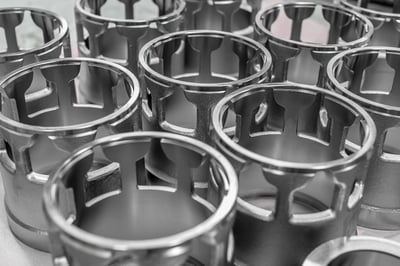Hard Chrome Plating 101

What is Hard Chrome Plating?
Hard chrome plating is an electroplating process that involves applying a layer of chromium to a surface by submerging it in a chromic acid solution.
Hard chrome increases durability, hardness, wear and corrosion resistance of metal components in order to have more effective use in machinery and equipment.
Benefits of Hard Chrome Plating
- Hardness: chrome plating is harder than most other metallic coatings. It withstands high stresses and demanding industrial applications.
- Corrosion resistance: hard chrome plating has extreme oxidization resistance.
- Durable thickness: plating between 10 and 500 micrometers will prove an enough hardness to protect machine components against wear during regular operation or in harsh conditions.
- Low deposition temperature: applying hard chrome at low temperatures ensures the properties of the substrate remain unaffected during the process.
- Excellent adhesion:hard chrome has very good adherence to many metal bases and almost no risk of flaking. In order to improve adhesion, parts have to be cleaned very well.
- Can be used in many base metals: hard chrome plating is applied to stainless steel and other high-alloyed steels as well as copper, aluminum, titanium, bronze, brass, and nickel.
- Low friction: hard chrome plating creates very little friction when in contact with metals, graphites, carbons, and polymers. Lower friction and reduced operating temperatures prevents parts from seizing and extends the lifespan of essential equipment components.
- Easy re-plating: easy to remove with stripping chemicals and replace with fresh plating.
Uses of hard chrome
Hard chrome is used by a variety of industrial applications in order to increase its wear and corrosion resistance of equipment components. Hard chrome reduces friction between machine parts and improves the durability of parts and its components. Hard chrome plating extends the lifespan of machine components and reduces maintenance downtime and expenses.
Hard chrome plating is also used when repairing worn or damaged machine parts. If a thick coating of hard chrome is applied to a worn-down component, it will return to its correct dimensions. This is done by stripping the damaged plating through a chemical process and then a new hard chrome plating is applied.
There are many base metals hard chrome can be applied to; these include steel, stainless steel, copper, brass bronze and more. The thickness of the chrome plating can vary depending on its specific purpose. The strength and durability of hard chrome plating came it very beneficial in a variety of applications such as hydraulic cylinders, piston rings, valves, mechanical and automotive parts, agricultural equipment, and much more. Hard chrome plating is effective for moving parts like rotors and pistons to reduce operating temperatures and improve lifespan of equipment parts; hard chrome can benefit nearly any machine component or part.
Hard chrome is very popular choice for the food and beverage processing industry. Its superior corrosion resistance makes it very effective in chemical, pharmaceutical, and oil and gas applications. You can use hard chrome plating with most gases and organic acids for processing materials like fruits, beer, brines, milk, oils and molten gas. Other industries such as printing, textiles, mining, agriculture, paper, manufacturing, and many others utilize hard chrome. Chrome resists harsh sanitizers and cleaning agents, so one can clean components where sanitation is crucial.
Chrome Plating Plants
For an example of a Chrome Plating Plant, and processes it can be used for please check out one of our Direct From Site success stories. Riley Surface World successfully worked with JCB to decommission and sell a chrome plating plant to a new market.
Machines & equipment for sale
- Surface Treatment
- Cleaning & Degreasing
- Polishing & Belt Linishing
- Mass Finishing
- Ovens & Furnaces
- Process Cooling
- Shot Blasting
- Dust & Fume Extraction
- Air Compressors
- Rectifiers & Transformers
- Miscellaneous
- Latest Stock
- Special Offers
- Direct From Site Clearances
- Auctions
- Brand New Machines
- Available Immediately
- Sell Your Machine
Machine Alert
Get the latest machines emailed directly to you as they become available to buy online. Sign Up Now

